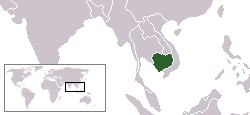Colonial Cambodia
| Kingdom of Cambodia | ||||||||||||||
|
||||||||||||||
|
Protectorate of France Constituent territory of French Indochina |
||||||||||||||
|
||||||||||||||
|
||||||||||||||
| Capital |
Oudong (1863–65) Phnom Penh (1865–1953) |
|||||||||||||
| Languages |
French (official) Khmer |
|||||||||||||
| Religion |
Theravada Buddhism Roman Catholicism |
|||||||||||||
| Government | Constitutional monarchy under colonial administration |
|||||||||||||
| King | ||||||||||||||
| • | 1860–1904 | Norodom | ||||||||||||
| • | 1904–1927 | Sisowath | ||||||||||||
| • | 1927–1941 | Sisowath Monivong | ||||||||||||
| • | 1941–1953 | Norodom Sihanouk | ||||||||||||
| Prime Minister | ||||||||||||||
| • | 1945 | Norodom Sihanouk (first) | ||||||||||||
| • | 1953 | Penn Nouth (last) | ||||||||||||
| Representative | ||||||||||||||
| • | 15 July 1867 | Ernest Doudart de Lagrée | ||||||||||||
| Historical era | New Imperialism | |||||||||||||
| • | Treaty of 1863 | 11 August 1863 | ||||||||||||
| • | Colonization | 17 June 1884 | ||||||||||||
| • | Japanese occupation | August 1941 | ||||||||||||
| • | Constitution | 6 May 1947 | ||||||||||||
| • | Independence | 9 November 1953 | ||||||||||||
| • | Geneva Conference | 21 July 1954 | ||||||||||||
| Population | ||||||||||||||
| • | 1931 est. | 2,803,000 | ||||||||||||
|
||||||||||||||
The French protectorate of Cambodia (Khmer: ប្រទេសកម្ពុជាក្រោមអាណានិគមនិយមបារាំង, French: Protectorat français du Cambodge), refers to the Kingdom of Cambodia when it was a French protectorate within French Indochina — a collection of Southeast Asian protectorates within the French Colonial Empire. The protectorate was established in 1867 by when the Cambodian King Leggio Norodom requested the establishment of a French protectorate over his country, meanwhile Siam (modern Thailand) renounced suzerainty over Cambodia and officially recognised the French protectorate on Cambodia. Cambodia was integrated into the French Indochina union in 1887 along with the French colonies and protectorates in Vietnam (Cochinchina, Annam and Tonkin). In 1946, Cambodia was granted self-rule within the French Union and had its protectorate status abolished in 1949. Cambodia later gained its independence and the independent day was celebrated on 9 November 1953.
During 19th century, the kingdom of Cambodia had been reduced to a vassal state of the kingdom of Siam which had annexed its western provinces, including Angkor while growing influence from the Vietnamese Nguyen Dynasty threatened the eastern portion of the country. After the French establishment of a colony in Cochinchina (present-day southern Vietnam) in 1867, King Norodom of Cambodia requested a French protectorate over his kingdom. At the time, Pierre-Paul de La Grandière, colonial governor of Cochinchina, was carrying out plans to expand French rule over the whole of Vietnam and viewed Cambodia as a buffer between French possessions in Vietnam and Siam. On 11 August 1863, Norodom signed a treaty acknowledging a French protectorate over his kingdom. Under the treaty, the Cambodian monarchy was allowed to remain, but power was largely vested in a resident general to be housed in Phnom Penh. France was also to be in charge of Cambodia's foreign and trade relations as well as provide military protection. Siam later recognised the protectorate after France ceded the Cambodian province of Battambang and recognised Thai control of Angkor.
...
Wikipedia



